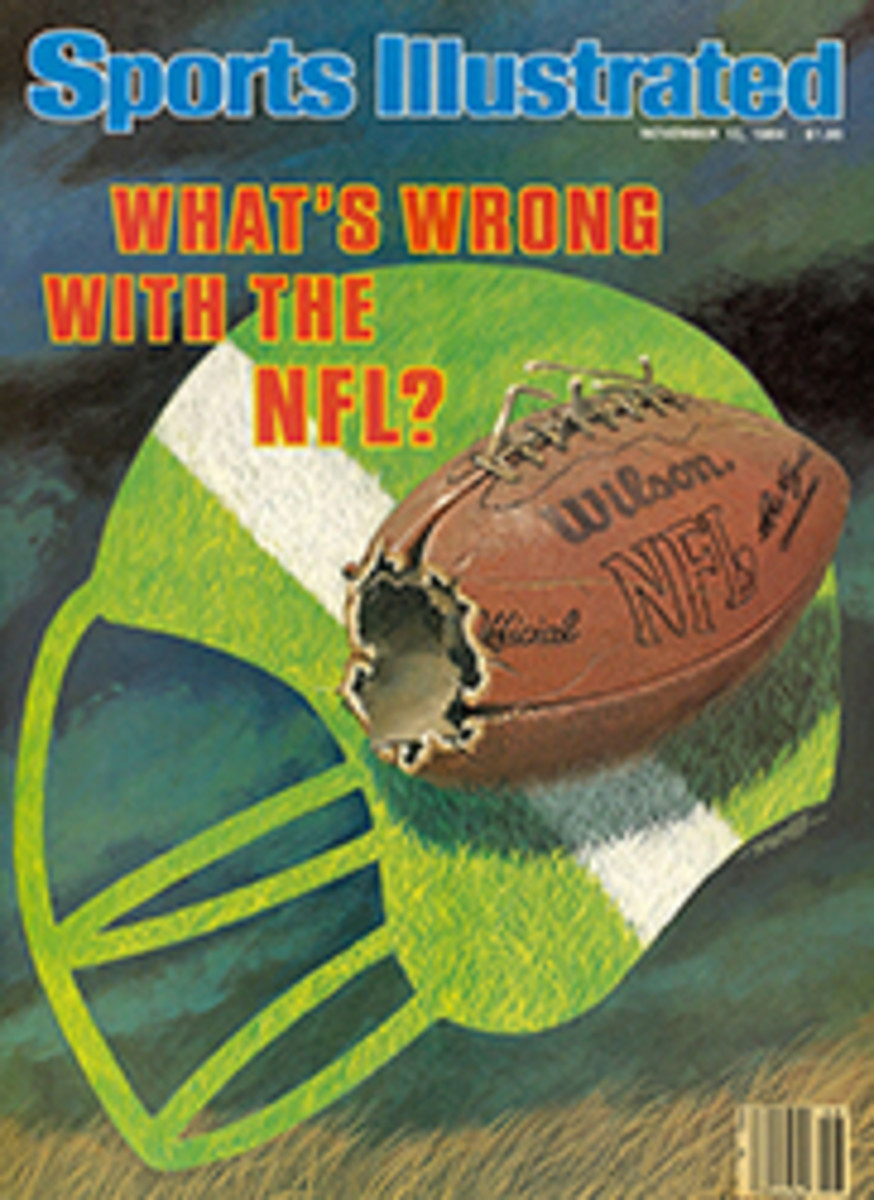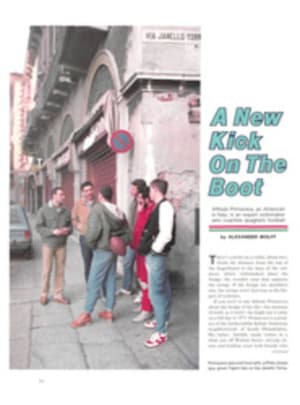
DREISSIGACKER SYNTHETIC OARS HAVE SWEPT BY THE TRADITIONAL WOODIES
The best racing oars are not manufactured, as might be expected, in some high-tech European rowingwerk. No, the oar that has cornered the U.S. collegiate and national racing market is handcrafted out of the latest material in a former cow barn in tiny landlocked Morrisville, Vt. (pop. 2,074).
The wizards behind this space-age oar, which is made of carbon fiber, fiber glass and plastic instead of the traditional Sitka spruce, are brothers Dick and Peter Dreissigacker. What Wilbur and Orville Wright did in their bicycle shop for the airplane, Dick, 37, and Pete, 33, have done in their cow barn for the non-wood racing oar—they've made one that works. This is no small accomplishment. Other oarmakers have tried to mass-produce synthetic oars and have failed, either because their finished product was too expensive or wasn't what the finicky racing world wanted. The Dreissigackers have created one that is lighter, cheaper, more durable and more consistent from oar to oar than any wooden model on the market. Rowing folk everywhere are singing its praises.
"It's definitely the best in the world," says U.S. men's eight coach Kris Korzeniowski, whose crew used Dreissigackers in this year's Olympics. "I've seen carbon fiber blades [oars] from England, but they couldn't touch the Dreissigacker in quality or price." A Dreissigacker sweep oar costs $185, compared with $250 or more for an equivalent wooden one, and sculls run $260 a pair, compared with that or more per wooden pair. Dreissigackers can be ordered in a variety of blade widths and shaft stiffnesses, and the brothers guarantee that the oars in each set are perfectly matched. "That's a significant improvement over the wooden oar," says Korzeniowski, "where there can be so much variation in flexion from oar to oar that you literally have to go through hundreds to find eight that match. With Dreissigackers, that's never a problem."
Nor are durability and maintenance, say rowing people sold on the synthetic oars. "If you drop a Dreissigacker, the blade doesn't chip the way a wooden oar does," says University of Washington crew coach Dick Erickson, "and you don't have to worry about sanding and varnishing them. We figure we get about a million flexes out of a wooden oar before the stress on it changes its characteristics and it breaks down. We don't see that happening with our Dreissigackers."
Since 1977, when the brothers began manufacturing the oar, they have sold more than 10,000 of them. Their customers have included almost every college, prep and high school and club crew in the country. Their international clients include teams from Japan, England, Italy, West Germany, Switzerland, France, Holland, Canada and Australia. This year they expect to sell 2,000 oars and sculls worldwide.
At 6'4" and 185 pounds (Dick) and 6'4", 195 (Pete), the brothers look like retired decathletes gone rural. Both are quiet and easygoing, favor jeans and flannel shirts around the oar barn and have quick minds keen on problem solving. "Dick has more of a one-track mind than I do," says Pete. "He'd rather work on one big problem for a week than lots of little ones." Says Dick, "Pete's good at parceling out his time, putting on different hats, switching from one problem to the next."
They have been designing and building things as a team since their childhood in suburban Orange, Conn. They're the only children of Phillip and Ruth Dreissigacker. Encouraged by their parents, the boys spent blissful days together in the family garage workshop. They built such items as five-foot-wide circular kites that outsoared all challengers in the neighborhood and perhaps the world's first sailing bicycle, which Pete recalls "sailed great going downhill."
Upon graduating from Amity Regional High—where Dick, class of '65, played football and ran track and Pete, '69, played football and basketball and threw the discus—both decided to study product design and engineering, Dick at Brown, Pete at Stanford. While in college, Dick got so hooked on crew that, after four years of rowing for coach Vic Michalson there, he joined Philadelphia's prestigious Vesper Boat Club. He made the '70 and '71 U.S. national teams in the heavyweight eights and fours, respectively, and the '72 U.S. Olympic team in the coxless four.
To his disappointment, his boat didn't make the semifinals at the Munich Games. There followed a year of soul-searching cum ski-bumming in Colorado that led to a decision to go to Stanford (Pete was entering his fifth year there) to coach the varsity crew and take a master's in industrial engineering.
That year, 1974, was a landmark one for the brothers as a design team. Dick took Pete and Pete's future wife, Bari, out on San Francisco Bay and taught them rowing, and Pete showed Dick a design he'd done as a class project: an external-frame backpack with a flexible hip connection that moved with the hiker. They decided to collaborate on getting the pack manufactured and spent the next two years developing it in conjunction with The North Face outdoor supply company of Berkeley, Calif. The result was a patent for the brothers and a licensing arrangement with North Face to make the pack under the product name Back Magic.
In 1977 they launched their design company, Concept II. "Our plan," says Pete, "was to keep a notebook of product ideas, and when we came up with a good one to develop it and see if we could market it, as we did with the Back Magic."
After failing to win a pairs slot on the '76 Olympic rowing team—that row on San Francisco Bay served to make Pete a fanatical oarsman, too—the brothers set up shop in the Green Mountain ambience of Morrisville. With $6,000 from North Face royalties and savings, they made a down payment on the Lowe farm on Route 100. On Nov. 8, 1976, they began fixing up the old red barn as a work space for their pet project: the construction of a synthetic racing oar. From their Stanford days they had noted that while racing shells were developing, oars weren't. Says Dick: "By the mid-'70s, boatbuilders were building shells with composites of carbon fiber, which is light but incredibly stiff, and fiber glass and other synthetics, but the oar remained this wooden accessory that no one was paying any attention to and that hadn't really changed in a hundred years. Our thought was why not take the same technology being used in boats and make what we felt would be the super oar."
After six months of trial and error, the Dreissigackers made their first prototypes—nearly going broke in the process. In the summer of 1977, they drove around the Northeast in Dick's decrepit VW Beetle, showing their oar to rowers and coaches. Yale coach Tony Johnson was smitten immediately.
"One thing I liked right off," says Johnson, "was that the brothers' oar, at seven pounds, was two pounds lighter than a wooden oar, which meant that an eight would carry 16 pounds less weight. It's also balanced differently—there's less weight in the hands—which means an oarsman doesn't have to push down so hard to get the blade out of the water on the release, and thus he's doing less work over a period of time. In a boat race, that's important."
The '78 Eastern Sprints, in which Yale, using Dreissigackers, beat wooden-winged Harvard, was one of those timely occurrences that marketing types pray for. To this day, neither the brothers, Johnson nor Harvard coach Harry Parker attributes Yale's win to the oars. Says Johnson, "We could've won in a bathtub that day." Parker adds, "And besides, we did beat them [Yale] a couple weeks later in the Harvard-Yale Race, which is over a longer course." Nonetheless, after Yale's victory, orders for The Oar That Helped Beat Harvard began materializing in Concept II's mailbox. From hopes of selling 100 oars a year, the brothers now find themselves selling 150 to 200 a month.
Over the years the Dreissigacker oar has undergone minor modifications; today it consists of a sandwich blade of molded plastic foam (for lightness), carbon fiber (for strength and stiffness) and fiber glass (for durability); a shaft of fiber glass and carbon fiber; a basswood handle and plastic sleeves and collars (against which the oars rest in their locks). Four men work five days a week making, on average, 10 sweeps and four sculls a day.
In 1981, the brothers invented the natural sequel to their oar—a sophisticated yet simple rowing machine called the Concept II Rowing Ergometer. Priced at $595, it consists of a sliding seat and a handle/drive chain/flywheel mechanism that simulates the momentum of a rowing shell. Already the brothers have sold 4,000 of the machines, which have spawned a series of indoor regattas around the country, most notably the Crash-B Sprints held at Harvard in February. Crash-B stands for Charles River Association of Sculling Has-Beens, the rowing club that sponsors the regatta, and this year 300 contestants raced 20 at a time on separate machines to see who could do a five-mile piece the fastest.
Also staying in one place while going very fast are the Dreissigackers, Wilbur and Orville, welcome two more to the brotherhood.
PHOTO
JOHN D. HANLON
In the barn, Dick (left) checks a blade for straightness, while Pete puts glue on a handle.

